Overview
Features
How to Recover
More Information
Related Products
Why DataNumen PowerPoint Recovery?
#1 Recovery
Rate
10+ Million
Users
20+ Years of
Experience
100% Satisfaction
Guarantee
Extremely Simple Interface
Main Features
- Support Microsoft PowerPoint 2007, 2010, 2013, 2016, 2019, 2021, PowerPoint for Office 365 and Microsoft 365 pptx files.
- Recover slide masters, layouts, slides, notes masters, notes, handout masters and themes.
- Recover all kinds of media, including pictures, 3D models, videos and audios.
Using DataNumen PowerPoint Recovery to Recover Corrupted PPTX Files
Start DataNumen PowerPoint Recovery.
Note: Before recovering any corrupt or damaged PPTX files with DataNumen PowerPoint Recovery, please close any other applications that may modify the PPTX files.
Select the corrupt or damaged PPTX file to be recovered:
You can input the PPTX filename directly or click the button to browse and select the file. You may also click the
button to find the PPTX file to be recovered on the local computer.
By default, DataNumen PowerPoint Recovery will save the recovered PPTX file into a new file named xxxx_fixed.PPTX, where xxxx is the name of the source PPTX file. For example, for source PPTX file Damaged.PPTX, the default name for the recovered file will be Damaged_fixed.PPTX. If you want to use another name, then please select or set it accordingly:
Select Fixed File Name
You can input the recovered file name directly or click the button to browse and select the recovered file.
Click the button, and DataNumen PowerPoint Recovery will start scanning and recovering the source PPTX file.
will indicate the data recovery progress.
After the recovery process, if the source PPTX file can be recovered successfully, you will see a message box like this:
Now you can open the recovered PPTX file with Microsoft PowerPoint.
More Information
Are there any free ways to repair corrupt PowerPoint files?
Yes, there are some free ways you can try to repair corrupt PowerPoint files manually. Most of them work for both corrupt PPT files and PPTX files.
1. Copy the file to a new location
Sometimes, PowerPoint cannot load the PowerPoint presentation file just because it is located on unreliable storage devices, such as a network drive, an external hard drive, etc. So you can fix the issue by:
- Copy the file to a new location, such as a local hard drive.
- Start Microsoft PowerPoint.
- Click File > Open to open the presentation file from the new location.
2. Open and Repair the Corrupt Presentation in PowerPoint
Like the other software in the Microsoft Office suite, PowerPoint has a built-in repair function. You can repair a damaged presentation as follows:
- Open PowerPoint.
- Click the File menu, then click Open.
- In the Open dialog, browse and select the corrupt PowerPoint presentation.
- Click the arrow beside the Open button, and select Open and Repair.
- If MS PowerPoint can open and repair the file successfully, you can see the presentation in PowerPoint.
- Click the File menu, then click Save As to save the presentation with a new name.
3. Open the file in safe mode
If PowerPoint fails to open the damaged PowerPoint file in normal mode, you can try to open it in safe mode:
- Click the Start menu.
- In the search box, input powerpnt.exe /safe and press Enter.
- MS PowerPoint will start. Make sure there is a (Safe Mode) in the title bar.
- Click the File menu, then select Open to open the corrupt PowerPoint file.
- If you can open it successfully, then click File > Save As to save it with a new name.
4. Insert slides and template to a new presentation
Sometimes you may fail to open the corrupt presentation in either normal or safe mode, but the slides and template in the presentation are still accessible. So, you can recover them by creating a new presentation, as below:
- Start PowerPoint.
- Click File > New.
- Select Blank Presentation as the template, and click Create.
- Now you have created a blank presentation.
- Click the Home tab.
- Click the arrow beside the New Slide button. Then click Reuse Slides.
- In the Reuse Slides panel, click Browse.
- Select the damaged presentation. Then click Open.
- If PowerPoint can read some or all slides in the damaged presentation, you will see them in the panel.
- Check the Keep source formatting option at the bottom of the panel.
- Right-click the slide you want to insert. Then select Insert Slide to insert it into the current presentation.
- If you want to insert all slides, then just right-click and select Insert All Slides.
- Click File > Save to save the presentation as a new name.
- If the layout or theme of the current presentation is not desired, you can apply the damaged PowerPoint file as the template.
- Click the Design tab.
- In the Themes group, click the arrow in the right-bottom corner.
- In the popup window, select Browse for Themes.
- Select the corrupt presentation, then click Apply.
- PowerPoint will apply the theme in the corrupt presentation to the current one.
5. Recover from a temporary file
MS PowerPoint will create a temporary version for the current presentation when you edit it. If your current file is corrupt, you may try to recover your data from the temporary version. The temporary version is saved as PPT####.tmp, where #### is a four-digit number. It may be saved in the same folder as the original presentation. Or in the system temporary folder. If you cannot find it, you can use the search function in Windows to search the whole computer for such files.
Once you get the temporary file, you can do as follows:
- Rename the file by changing its extension from .tmp to .pptx.
- Open PowerPoint.
- Click File > Open to open the file.
- If you can open it successfully, then click File > Save As to save it as a new file.
- You can also double-click the file to open it in PowerPoint directly.
6. Recover from AutoRecover information
PowerPoint has a built-in auto-recovery feature. So, if all the above methods do not work, you can check if there are any AutoRecover files available:
- Start Microsoft PowerPoint.
- Click File > Options.
- In the PowerPoint Options dialog, click the Save tab.
- In the Save presentations section, find the AutoRecover file location.
- In Windows Explorer, go to that location and find your file over there. The AutoRecover files are saved as *.tmp or *.pcb files. And they are named with random hexadecimal digits, like ppt433F.tmp. So you may need to try and test to determine which file is the wanted one.
- If you find the file, copy it to a new location. And rename it to .pptx extension.
- Click File > Open to open the presentation file.
If all the above methods fail, you can use our tool to repair corrupt PowerPoint files.
Which versions of Windows are supported?
Currently, our repair tool supports all versions of Windows, including Windows 95/98/ME/NT/2000/XP/Vista/7/8/8.1/10/11 and Windows Server 2003/2008/2012/2016/2019. Both 32bit and 64bit are supported.
Which file types are supported?
Currently, our PowerPoint repair tool only supports *.PPTX files (Microsoft Office 2007 and later). It does not support to repair corrupt PPT files(Microsoft Office 97-2003) as *.PPT files are older than nearly 20 years and not many are still using these file types.
What are the requirements for your tool?
- Windows 95/98/ME/NT/2000/XP/Vista/7/8/8.1/10/11 and Windows Server 2003/2008/2012/2016/2019.
- One of the following MS PowerPoint versions is installed on your local computer: PowerPoint 2007, PowerPoint 2010, PowerPoint 2013, PowerPoint 2016, or PowerPoint 2019.
Do you support to recover the embedded media files?
Yes, our repair software can recover the embedded media files, including images, videos, and other media files, and put them back to the output presentation file.
Can you output the embedded media files to a separate directory?
Sorry but currently our PowerPoint data recovery tool will only recover the media files and put them back to the output presentation. It cannot output the media files to a separate directory.
Can you recover the slide master?
The slide master works like a template in the PowerPoint presentation. Our PowerPoint repair software can recover not only the slides, but also the slide master.
Do you support to recover PowerPoint files in Mac?
Yes, you can do as follows:
- Copy the damaged PowerPoint presentation file from the Mac to a PC.
- Install our tool on the PC.
- Repair the damaged presentation file.
- Copy the fixed presentation file back to the Mac computer.
Why a PowerPoint presentation will get corrupt?
There are many reasons that lead to PowerPoint file corruption, such as hard drive failures, storage device errors, viruses, MS PowerPoint crashes, unreliable network connections, etc. We recommend you to have a copy of our tool. So when corruption occurs, you can use our tool to fix the corrupt PowerPoint presentation as soon as possible.
How long does the recovery process take?
The time depends on several factors:
- Total number of slides.
- Total number of other components, such as slide masters, layouts, etc.
- Total size of the MS PowerPoint file.

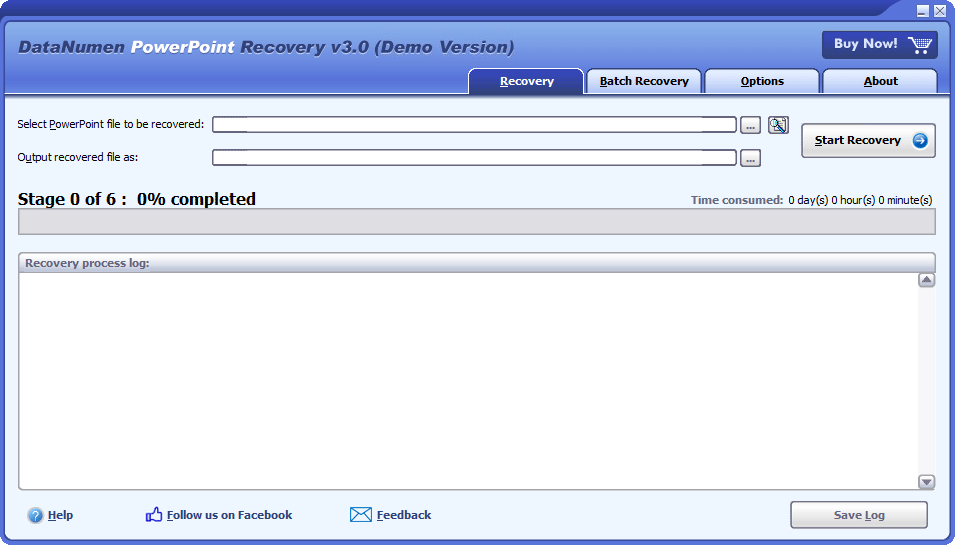
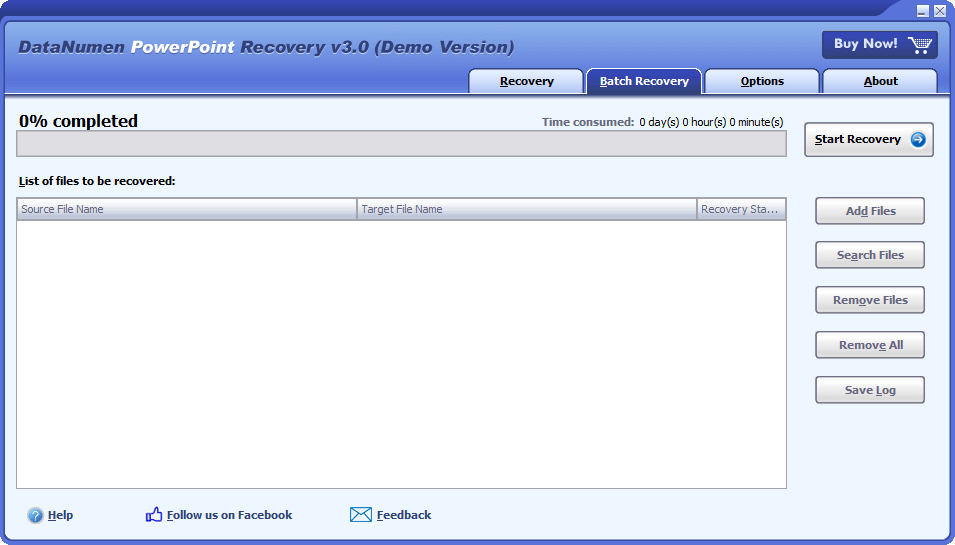
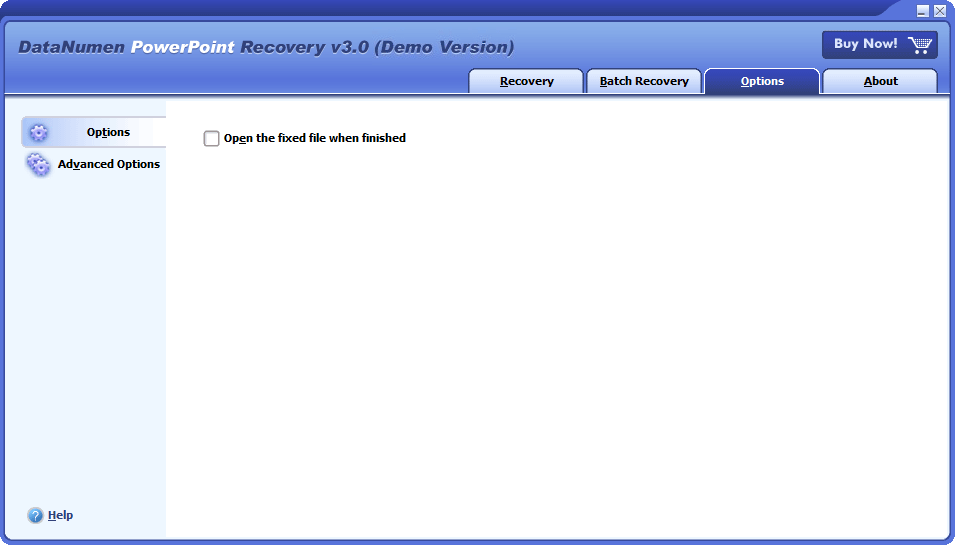


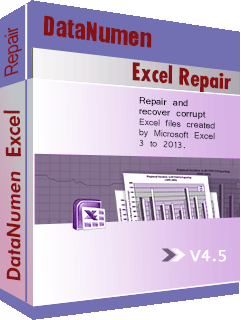
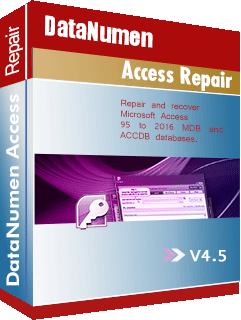
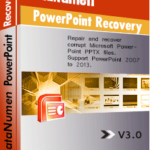 DataNumen PowerPoint Recovery
DataNumen PowerPoint Recovery